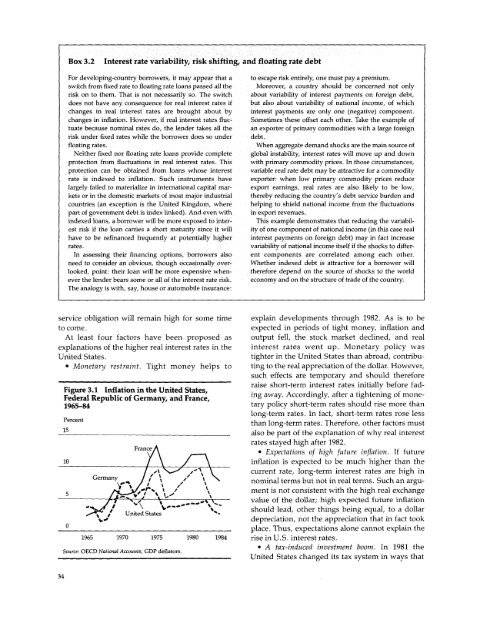World Bank Document
World Bank Document
World Bank Document
Create successful ePaper yourself
Turn your PDF publications into a flip-book with our unique Google optimized e-Paper software.
Box 3.2<br />
Interest rate variability, risk shifting, and floating rate debt<br />
For developing-country borrowers, it may appear that a to escape risk entirely, one must pay a premium.<br />
switch from fixed rate to floating rate loans passed all the Moreover, a country should be concerned not only<br />
risk on to them. That is not necessarily so. The switch about variability of interest payments on foreign debt,<br />
does not have any consequence for real interest rates if but also about variability of national income, of which<br />
changes in real interest rates are brought about by interest payments are only one (negative) component.<br />
changes in inflation. However, if real interest rates fluc- Sometimes these offset each other. Take the example of<br />
tuate because nominal rates do, the lender takes all the an exporter of primary commodities with a large foreign<br />
risk under fixed rates while the borrower does so under debt.<br />
floating rates.<br />
When aggregate demand shocks are the main source of<br />
Neither fixed nor floating rate loans provide complete global instability, interest rates will move up and down<br />
protection from fluctuations in real interest rates. This with primary commodity prices. In those circumstances,<br />
protection can be obtained from loans whose interest variable real rate debt may be attractive for a commodity<br />
rate is indexed to inflation. Such instruments have exporter: when low primary commodity prices reduce<br />
largely failed to materialize in international capital mar- export earnings, real rates are also likely to be low,<br />
kets or in the domestic markets of most major industrial thereby reducing the country's debt service burden and<br />
countries (an exception is the United Kingdom, where helping to shield national income from the fluctuations<br />
part of government debt is index linked). And even with in export revenues.<br />
indexed loans, a borrower will be more exposed to inter- This example demonstrates that reducing the variabilest<br />
risk if the loan carries a short maturity since it will ity of one component of national income (in this case real<br />
have to be refinanced frequently at potentially higher interest payments on foreign debt) may in fact increase<br />
rates.<br />
variability of national income itself if the shocks to differ-<br />
In assessing their financing options, borrowers also ent components are correlated among each other.<br />
need to consider an obvious, though occasionally over- Whether indexed debt is attractive for a borrower will<br />
looked, point: their loan will be more expensive when- therefore depend on the source of shocks to the world<br />
ever the lender bears some or all of the interest rate risk. economy and on the structure of trade of the country.<br />
The analogy is with, say, house or automobile insurance:<br />
service obligation will remain high for some time explain developments through 1982. As is to be<br />
to come. expected in periods of tight money, inflation and<br />
At least four factors have been proposed as output fell, the stock market declined, and real<br />
explanations of the higher real interest rates in the interest rates went up. Monetary policy was<br />
United States. tighter in the United States than abroad, contribu-<br />
Monetary restraint. Tight money helps to ting to the real appreciation of the dollar. However,<br />
such effects are temporary and should therefore<br />
Figure 3.1 Inflation in the United States, raise short-term interest rates initially before fad-<br />
Federal Republic of Germany, and France, ing away. Accordingly, after a tightening of mone-<br />
1965-84 tary policy short-term rates should rise more than<br />
Percent long-term rates. In fact, short-term rates rose less<br />
than long-term rates. Therefore, other factors must<br />
15 also be part of the explanation of why real interest<br />
Franc\<br />
rates stayed high after 1982.<br />
* Expectations of high future inflation. If future<br />
10 inflation is expected to be much higher than the<br />
current rate, long-term interest rates are high in<br />
Germany / t nominal terms but not in real terms. Such an argu-<br />
5 s " / \ <<br />
ment is not consistent with the high real exchange<br />
,f+ 9 ~so\' s ' ___,\\^ - value of the dollar; high expected future inflation<br />
-C it UnitedStates \^ should lead, other things being equal, to a dollar<br />
so U depreciation, not the appreciation that in fact took<br />
0 place. Thus, expectations alone cannot explain the<br />
1965 1970 1975 1980 1984 rise in U.S. interest rates.<br />
Source: OECD National Accounts, GDP deflators.<br />
* A tax-induced investment boom. In 1981 the<br />
United States changed its tax system in ways that<br />
34

















